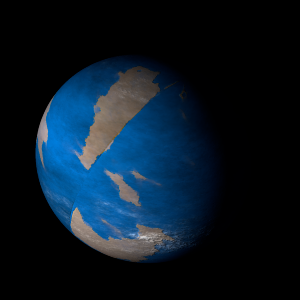|
|
Space Astro
|
Info for exoplanet "Weiqweng'dya"
| Scientific (actual) data |
|---|
| Planet | TOI-1227 b |
| Planet status | Confirmed |
| Radius | 0.854 |
| Orbital period | 27.364 |
| Semi major axis | 0.0886 |
| Inclination | 88.571 |
| Discovered | 2021 |
| Updated | 2021-10-20 |
| Tzero tr | 2458620 |
| Impact parameter | 0.849 |
| Publication | Published in a refereed paper |
| Detection type | Radial Velocity |
| Radius detection type | Primary Transit |
| Star name | TOI-1227 |
| Right ascension | 186.77° |
| Declination | -72.45° |
| Mag v | 15 |
| Star distance | 100.96 |
| Star mass | 0.17 |
| Star radius | 0.56 |
| Star sp type | M4.5V |
| Star age | 0.011 |
| Star temperature | 3072 |
| Wikipedia article | TOI-1227 b |
Back
| |
| Fictional info (?) |
|---|
| Suggested name | Weiqweng'dya |
| Planet type | Planet |
| This planet is named after the deity Weiqweng'dya, the bringer of dreams.
Two spacecraft have visited Weiqweng'dya: Daedalus 8 flew by 44 years ago; and Messenger, launched 20 years ago, orbited Weiqweng'dya over 95 times in four years before exhausting its fuel and crashing into the planet's atmosphere 11 years later.
The rotational period and seasonal cycles of Weiqweng'dya are likewise similar to those of Wujai'h, as is the tilt that produces the seasons.
The two polar ice caps appear to be made largely of methane ice. The volume of water ice in the south polar ice cap, if melted, would be sufficient to cover the entire planetary surface to a depth of 7 meters.
It may also have a rocky core of heavier elements, but like the other planets, Weiqweng'dya lacks a well-defined magnetic field. |
| Atmosphere | Ammonium hydrosulfide (NH4SH) | 53% |
| Hydrogen | 18% |
| Sulfur dioxide | 16% |
| Nitric oxide | 9.1% |
| Neon | 4.1% |
| Ozone | 0% |
| Atmospheric pressure | 0.13 bar |
 |
| No known satellites |
| Google search for Weiqweng'dya |
|
Website by Joachim Michaelis
|
|
|
|